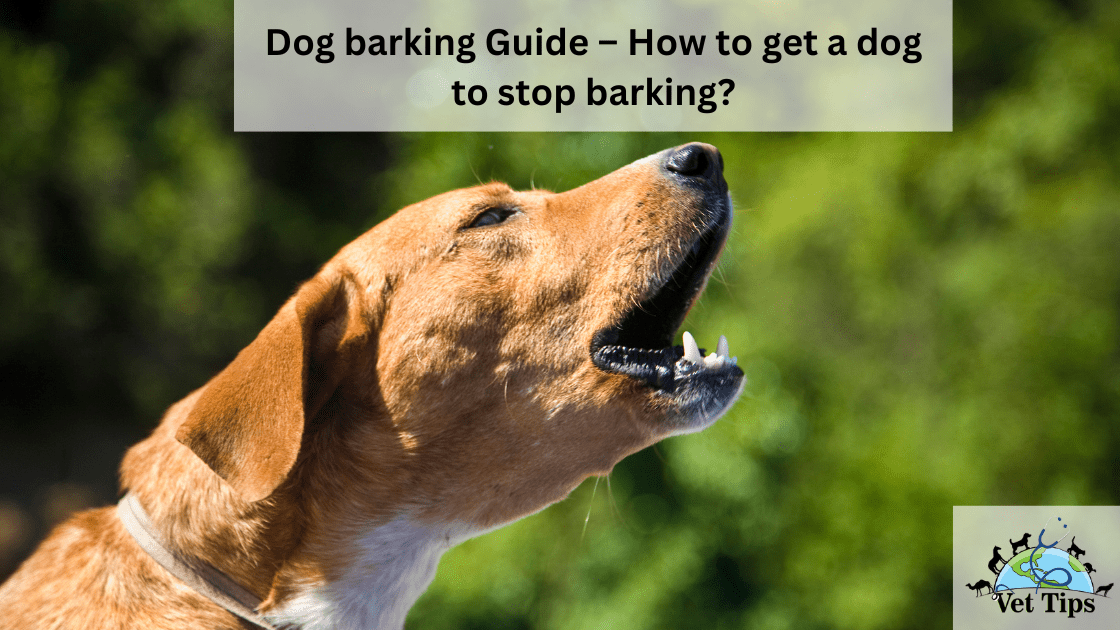Dogs are our loyal companions, but sometimes their barking can become a bit overwhelming. Whether triggered by excitement, alertness, or boredom, excessive barking needs to be managed for the peace and sanity of both you and your furry friend. In this guide, we’ll explore effective strategies to help you get your dog to stop barking excessively while ensuring their well-being and happiness.
Understanding the Bark
Before diving into methods to curb barking, it’s crucial to understand why dogs bark in the first place. Barking is a natural form of communication for canines. It can signify a range of emotions, such as excitement, fear, territorial instinct, or even boredom. Identifying the underlying cause of your dog’s barking is the first step toward addressing the issue.
Dogs communicate in the same way that we do, using both vocal and nonverbal clues. It is natural for dogs to bark, and it is one of the most efficient ways that they know how to communicate with their owners.
Dogs utilize barking to express a range of emotions; therefore, pet owners must interpret a dog’s vocal signals in order to comprehend what a dog is communicating completely.
Reasons: Why Do Dogs Bark?
Here’s a summary of the most frequent reasons why dogs bark to help you better understand what your dog may be attempting to communicate with you.
1. Excitement Barks
Does your dog bark when you return home, or does it start barking when they hear the familiar sound of you putting on their leash? Those are barks of enthusiasm/excitement, to be sure.
Yipping and yowling are two of the most common methods in which dogs convey their excitement to one another. Dogs generally bark in a high-pitched or middle range when they are excited. They will give out approximately one or two barks every few minutes until the enthusiasm has subsided.
The barks are frequently accompanied by a wagging tail and an alert—but happy—body stance on the part of the dog (ears perked and head held higher).
It is typical for them to do so and spin in circles and tap their feet fast. This demonstrates their enthusiasm and should convey to you the message: Let’s start playing!
2. Attention and Meal Seeking Barks
Occasionally, a dog may bark at you in an attempt to gain your attention. This style of barking is typically characterized by a long string of single barks separated by brief pauses.
Depending on the pet and the scenario, they may request that you take them for a walk or feed them something.
Their body language is frequently less active and calmer. Their tails may be straight or wagging, and they may have their ears down/naturally or at attention, depending on the situation.
However, you should use caution when engaging in this sort of barking. Barking to earn treats, for example, and getting what they want as a result teaches them that barking is an effective method of obtaining their desired reward. If this is the case, your dog may bark incessantly in order to obtain rewards.
3. Fear, anxiety, or territorial barking
When a strange person enter the home or your dog being trapped in a position with no apparent escape path, defensive barking is frequently heard by the dog’s owner.
In most cases, these barks will be stronger in tone, and they may even have a snarl to them. They will also be relatively constant and persistent in their nature.
When a dog feels nervous or afraid, his or her body language will typically feature a tail between the legs, hackles up, and a low head position.
If the dog simply barks to mark his territory, his body posture may involve his ears and head being drawn up and his tail being held straight. This is the dog’s method of letting you know that they are larger than you and could bite you.
4. Pain Barking
When a pup is in pain, he or she will bark. This signals to their pack that they need assistance or that a certain activity is causing them pain and that they wish it to cease, respectively.
This sort of barking is frequently heard when an animal is unintentionally hit during rough play or when they are being assaulted by another animal, among other things. The pain bark may be higher pitched and have a staccato aspect to it, or it may taper off as the bark continues to be produced.
If your dog barks in this manner when you touch or pet them, it is possible that something is hurting or that they are expecting pain due to being handled. This is a warning indication that your dog should be taken to the veterinarian to determine what is happening.
5. Surprise or Reactive Barking
This is usually a single bark, although a flurry of barks might follow it. In addition, the pitch is generally higher in order to convey surprise. Similar to how people react when they are shocked or scared, it is a mainly automatic response.
If you approach up to a dog that wasn’t paying attention or has weak hearing, or if they believe they see something moving fast in the grass, you may hear this.
Because they were most likely not prepared to bark in the first place, their bark may be uncontrolled, and their body position may be erratic.
Continue reading to learn more about how to get your dog to stop barking.
How to train a dog to stop barking?
Here is a list of five techniques that can be used to help keep your dog from barking excessively.
1. Ignore the barking
If you believe your dog is barking in order to seek your attention, ignore them as much it takes for them to stop barking completely. Don’t talk to them, don’t even look at them; don’t touch them even if it’s just to ask them to stop being noisy. It will only encourage them to continue to be loud. When they are finally quiet, even for a moment, give them the treat to show your appreciation.
2. Remove the source of motivation
When your dog barks, he or she receives some sort of reward. They wouldn’t do it if they didn’t have to. Determine what they are getting out of barking and eliminate it. Continue to avoid providing opportunities for your dog’s barking behavior to continue.
3. Exhaust your dog’s energy levels
Make sure that your dog receives sufficient physical and mental exercise daily. Boredom and frustration are less likely to cause barking in a tired dog, making it less likely to bark in general. Based on their breed, age, and health, your dog may require several long walks in addition to a good game of chasing the ball and playing with some interactive toys to keep them entertained.
4. Ask your dog for an incompatible behavior
If your dog begins to bark, instruct them to perform an action that is incompatible with barking. Teaching your dog to respond to barking stimuli with something that prevents them from barking, such as lying down on their bed, is an excellent way to prevent them from barking.
5. Consult with a certified professional dog trainer for assistance
If you believe your dog is reacting aggressively to strangers, family members, or other dogs, or if you have tried everything else and your dog still barks, consider seeking professional assistance from a certified professional dog trainer.
Conclusion: Dog Barking Guide – How to Get a Dog to Stop Barking?
Observing your dog’s body language and then looking for the trigger that caused the barking will help you figure out what’s going on with him.
If you understand why your canine companion is barking and make slight modifications around your home or in your daily routine, you may be able to prevent some of the annoying barkings.
Tell us in the comments, how you like our article “Dog barking Guide – How to get a dog to stop barking?”
For similar posts like this, click here.
For the source file, click here.





One thought on “Dog Barking Guide – How to Get a Dog to Stop Barking?”